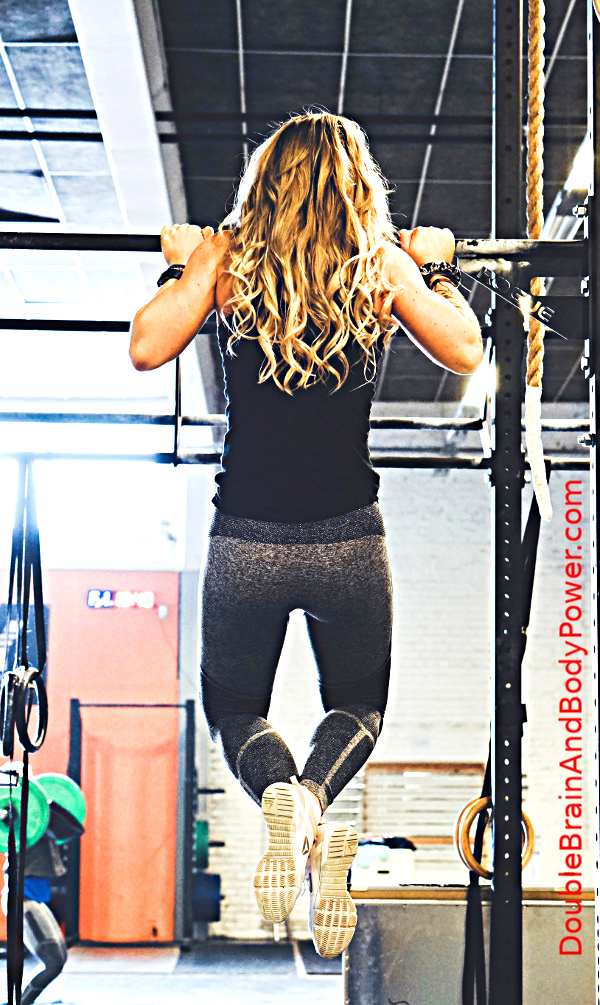Double Brain And Body Power
Home Articles Book Q&A About Contact
How To Use The Big Three Weight Training Methods For Building Muscle
by Mark Cammack May 22, 2018

The front Pull-up is an effective exercise that uses bodyweight for resistance. It is ideal for Same Sets training.
There are three weight training methods that I have seen that give consistent results. These are Same Sets, PILE Sets, and Drop Sets. They tend to be easy to use.
Years ago periodization programs were experimented with. We had hoped for a better outcome. This method uses preset time periods. For a number of weeks a certain type of training will occur and then it is changed. There are various forms of this approach.
An example would be to have an athlete beginning with high volume using the 10 x 10 routine. This means 10 sets of 10 repetitions of an exercise for 6 weeks. Then we lower the volume and increase the load with an 8 x 8 routine for 6 weeks. Finally we use a 6 x 6 measure. If the person is strength training, the last stage could drop to a 5 x 5 or 5 x 3, which are not recommended due to increased risk of injury.
Periodization agendas exist for weight lifting, power lifting, bodybuilding, and specific sports. The possibility for improvement is obvious: There is a need to provide a program that matches the bioindividuality of the athlete. It is difficult to gain the best results with an unyielding agenda.
There is another important need as well: To associate happiness with training. When listening to international athletes, some of high quality will state that they follow a flexible plan. They are doing what they enjoy in the gym. This approach tends to lower stress and increase positive results. This does not mean that they do not use guidelines or have a program, but instead it is based on their personal experience that works for them.
A mass prescribed program will never match one designed uniquely for the individual. Even better is to implement a full affector method such as with H.P.E. This ensures that the total person is functioning maximally in the total environment. These are training programs that may give the best chance of success when adapted:
Most persons are familiar with Straight Sets or Same Sets. It is simply taking a given weight for a number of repetitions, resting, and repeating. For example:
We are performing Parallel Bar Dips with our own weight for 5 sets of 10 repetitions. The bodyweight is the load and remains the same.
PILE sets are Progressive Increasing Load Exercise sets. In these we are increasing the weight each set. The number of repetitions may or may not be lowered with increasing weight. It depends upon how heavy a load a person lifts and their ability. Example:
We are doing Lat Machine Pull-downs. This is a typical progression:
40 kg (88 lbs) x 12 reps
50 kg (110 lbs) x 10 reps
70 kg (154 lbs) x 10 reps
80 kg (176 lbs) x 10 reps
100 kg (220 lbs) x 8 reps
The first set is intentionally light. It is part of the warm-up. A world-class athlete I knew did not believe in warm-up exercises. They received multiple surgeries due to repeated injuries. We want to keep our bodies healthy and injury-free. Warming-up is our friend.
Ideally we increase the repetitions or weight on the last set when possible. The repetitions can go up to 15 but usually not more than 20, and not lower than 6-8 for safety when adding weight. Using high weight and high repetitions is generally better than very high weight and low repetitions for building muscle.
The Drop Set is performing multiple sets without rest, and it tends to show fast results. The weight is lowered each set. Example:
We are doing seated calf raises. We begin with 200 kg (440 lbs) x 15 repetitions, drop to 150 kg (330 lbs) x 15, and then drop to 100 kg (220 lbs) for 20.
How do we know when to change training methods? It is based on what is working for the individual. Example:
John has been using PILE sets for eight weeks to help increase power and build up his body. He did really well, and then notices that he is not increasing in weight or repetitions on this program for three workouts. One odd workout may be a fluke, three usually indicate something else. We need to look at many factors including sleep, the environment, stress, nutrition, and more.
We may go through our check-list and it is OK. If so, then it is time to change methods because John's body is at an adaptational limit under current conditions. We could then choose between using either Same Sets or Drop Sets. John's personal body response and written training logs will help indicate the proper choice. It will also reveal the number of weeks his body takes to adapt to a program. This is a general guideline as ever-changing environmental affectors can alter John's physiology. We must constantly be aware of what is taking place as life is dynamic.
It is interesting that a general pattern is seen for many processes. Scar tissue formation, immune response, and some bodily reactions have a tendency to peak at about three weeks.
Images
Photo adapted by author from original work of Charlotte Karlsen.
© Copyright 2018-2019 Mark Cammack. All rights reserved.